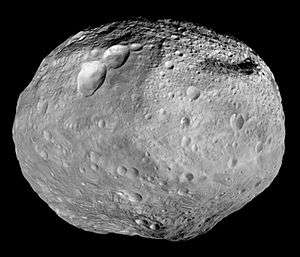Saturnalia Fossa

Saturnalia Fossa runs obliquely near the terminator at upper right of this full view of Vesta, with nearby grooves parallel to it.
Saturnalia Fossa /sætərˈneɪliə ˈfɒsə/ is the largest of the series of parallel Veneneian troughs in the northern hemisphere of the giant asteroid 4 Vesta. It is estimated to be approx. 39 km wide and is at least 365 km long; as of early 2012, one end disappeared in shadow and its total length was thus unknown. It is thought to be a shock fractures resulting from the impact that created Veneneia crater, which it is concentric with.[1] It is one of the longer chasms in the Solar System, and is named after the Roman festival of Saturnalia.[2]
See also
- Divalia Fossa, the largest of the Rheasilvian troughs.
References
- ↑ Exploration of Saturnalia Fossa and associated structures in Vesta's northern hemisphere, Paper No. 152-12, 2012 GSA Annual Meeting in Charlotte (4–7 November 2012)
- ↑ IAU/USGS (NASA coordinates)
This article is issued from Wikipedia - version of the 3/27/2016. The text is available under the Creative Commons Attribution/Share Alike but additional terms may apply for the media files.